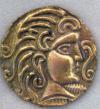Cooking A Comet: NASA's Solar Observing Fleet To Watch Comet ISON's Journey Around The Sun

It began in the Oort cloud, almost a light year away. It has traveled for over a million years. It has almost reached the star that has pulled it steadily forward for so long.
Taken on Nov. 19, 2013, this image shows a composite “stacked” image of comet ISON. These five stacked images of 10 seconds each were taken with the 20″ Marshall Space Flight Center telescope in New Mexico. This technique allows the comet’s sweeping tail to emerge with more detail.
Image credit: NASA/MSFC/MEO/Cameron McCarty
On Thanksgiving Day, Nov. 28, 2013, Comet ISON will finally sling shot around the sun. Here its inward journey through the solar system will end — either because it will break up due to intense heat and gravity of the sun, or because, still intact, it speeds back away, never to return.
Comet ISON appeared in the higher-resolution HI-1 camera on NASA’s STEREO-A spacecraft. Dark “clouds” coming from the right are more dense areas in the solar wind, causing ripples in Comet Encke’s tail. Using comet tails as tracers can provide valuable data about solar wind conditions near the sun.
Image Credit: Karl Battams/NASA/STEREO/CIOC
Catalogued as C/2012 S1, Comet ISON was first spotted 585 million miles away in September 2012. Scientists were instantly intrigued, not because spotting it so far away meant it might be very bright and beautiful once it was closer to Earth — though this may indeed turn out to be the case if it survives its trip around the sun — but because this is ISON’s very first trip into the inner solar system. That means it is still made of pristine matter from the earliest days of the solar system’s formation, its top layers never having been lost by a trip near the sun.
Officially labeled as Comet C/2012 S1, ISON can be seen in these images along with Earth, Mercury and Comet 2P/Encke. The tails streaking out from behind both comets can be seen moving along with the steady stream of particles – called the solar wind – that flows out from the sun.
Comet ISON entered the view of NASA’s Solar Terrestrial Relations Observatory on Nov. 21, 2013, where it can be seen with Earth, Mercury and comet 2P/Encke.
Image Credit: Karl Battams/NASA/STEREO/CIOC
Along Comet ISON’s journey, NASA has used a vast fleet of spacecraft and Earth-based telescopes to learn more about this time capsule from when the solar system first formed.
Comet ISON (Comet C/2012 S1) was still in one piece in this Hubble Space Telescope image taken on Oct. 9, 2013. A host of solar observatories will watch it slingshot around the sun Nov. 21-30 to see if it breaks up at that point or continues on intact.
Image Credit: NASA/ESA/Hubble Heritage Team (STScI/AURA)
During the last week of its inbound trip, ISON will enter the fields of view of several NASA Heliophysics observatories. Comet ISON will be viewed first by the broad field of view seen by NASA’s Heliospheric Imager instrument aboard its Solar Terrestrial Relations Observatory, or STEREO, Next the comet will be seen in what’s called coronagraphs, images that block the brighter view of the sun itself in order to focus on the solar atmosphere, the corona.
Comet ISON shows off its tail in this three-minute exposure taken on Nov. 19, 2013 at 6:10 a.m. EST, using a 14-inch telescope located at the Marshall Space Flight Center. The comet is just nine days away from its close encounter with the sun; hopefully it will survive to put on a nice show during the first week of December. The star images are trailed because the telescope is tracking on the comet, which is now exhibiting obvious motion with respect to the background stars over a period of minutes.
At the time of this image, Comet ISON was some 44 million miles from the sun — and 80 million miles from Earth — moving at a speed of 136,700 miles per hour.
Image credit: NASA/MSFC/Aaron Kingery
Such images will come both from STEREO and the joint European Space Agency/NASA Solar and Heliospheric Observatory, or SOHO. Then, NASA’s Solar Dynamics Observatory, or SDO, will view the comet for a few hours during its closest approach to the sun, known as perihelion. The X-Ray Telescope on the JAXA/NASA Hinode mission will also be looking at Comet ISON for about 55 minutes during perihelion.
All of these observatories will have different views. STEREO-B will be the only one that sees the comet transit across the face of the sun. In SDO’s view, the comet will appear to travel above the sun, and the SDO instruments will point away from the center of the sun to get a better view for three hours on Nov. 28. In addition to learning more about the comet itself, these observations can make use of the comet as a tracer to show movement in the solar wind and solar atmosphere.
The dates of viewings by these observatories are as follows:
Nov 21-28: STEREO-A Heliospheric Imager
Nov 26-29: STEREO-B coronagraphs
Nov 27-30: SOHO coronagraphs
Nov 28-29: STEREO-A coronagraphs
Nov 28: SDO
Nov 28: Hinode
As the new comet C/2012 S1 (ISON) and the well-known short-period comet 2P/Encke both approach their closest distances to the Sun later this month, they are also passing close to the MESSENGER spacecraft now orbiting the innermost planet Mercury. Just this week, both comets have brightened sufficiently to be captured in images by MESSENGER’s wide-angle camera. This figure shows, on the left, images of Encke on three successive days from November 6 to November 8; on the right, images of ISON are shown for three successive days from November 9 to November 11. Both comets appear to brighten each day (top to bottom). The images were acquired by the Wide Angle Camera (WAC) of the Mercury Dual Imaging System (MDIS) aboard NASA’s MESSENGER spacecraft.
Image Credit: NASA/Johns Hopkins University Applied Physics Laboratory/Carnegie Institution of Washington/Southwest Research Institute
Green circles indicate some of the brighter cataloged background stars in each image; yellow marks bracket the comets. The background stars are fixed in each image from top to bottom, so the motion of the comet relative to the stars is clear in each case. The images have been smoothed slightly to diminish the distracting sharp edges of the pixels.
MESSENGER is viewing these comets from a vantage point that is very different from that of observers on Earth. Comet Encke was approximately 0.5 AU from the Sun and 0.2 AU from MESSENGER when these images were taken; the same distances were approximately 0.75 AU and 0.5 AU, respectively, for ISON. More images will be obtained starting on November 16 when the comets should be both brighter and closer to Mercury.
The MESSENGER spacecraft is the first ever to orbit the planet Mercury, and the spacecraft’s seven scientific instruments and radio science investigation are unraveling the history and evolution of the Solar System’s innermost planet. During the first two years of orbital operations, MESSENGER acquired more than 150,000 images and extensive other data sets. MESSENGER is scheduled to continue orbital operations until late March 2015.
NASA’s Hubble Sees Comet ISON Intact
A new image of the sunward plunging comet ISON suggests that the comet is intact despite some predictions that the fragile icy nucleus might disintegrate as the sun warms it. The comet will pass closest to the sun on Nov. 28.
In this NASA Hubble Space Telescope image taken on Oct. 9, the comet’s solid nucleus is unresolved because it is so small. If the nucleus broke apart then Hubble would have likely seen evidence for multiple fragments.
Moreover, the coma or head surrounding the comet’s nucleus is symmetric and smooth. This would probably not be the case if clusters of smaller fragments were flying along. A polar jet of dust first seen in Hubble images taken in April is no longer visible and may have turned off.
Credit: NASA, ESA, and the Hubble Heritage Team (STScI/AURA)
This color composite image was assembled using two filters. The comet’s coma appears cyan, a greenish-blue color due to gas, while the tail is reddish due to dust streaming off the nucleus. The tail forms as dust particles are pushed away from the nucleus by the pressure of sunlight. The comet was inside Mars’ orbit and 177 million miles from Earth when photographed. Comet ISON is predicted to make its closest approach to Earth on Dec. 26, at a distance of 39.9 million miles.
Contacts and sources:
Karen C. Fox, NASA’s Goddard Space Flight Center
Ray Villard, Space Telescope Science Institute, Baltimore, Md.
For images and more information about comet ISON, visit: http://hubblesite.org/news/2013/42; ttp://heritage.stsci.edu/2013/42; http://hubblesite.org/go/ison; http://www.flickr.com/groups/comet_ison; http://www.nasa.gov/cometison
More stories:
High Tech Power Generation Older Than The Inca Claimed in South America By Researcher
17 Mysteries Awaiting Explanation
Cooking A Comet: NASA’s Solar Observing Fleet To Watch Comet ISON’s Journey Around The Sun
Strange Spacecraft: Whose Are They
13 World Mysteries Without Explanation
Grey Aliens Filmed By KGB, Russian Alien Autopsy
25,000 Year Old Buildings Found In Russia? The Mysterious Dolmens And Megaliths Of The Caucasus
Anyone can join.
Anyone can contribute.
Anyone can become informed about their world.
"United We Stand" Click Here To Create Your Personal Citizen Journalist Account Today, Be Sure To Invite Your Friends.
Before It’s News® is a community of individuals who report on what’s going on around them, from all around the world. Anyone can join. Anyone can contribute. Anyone can become informed about their world. "United We Stand" Click Here To Create Your Personal Citizen Journalist Account Today, Be Sure To Invite Your Friends.
LION'S MANE PRODUCT
Try Our Lion’s Mane WHOLE MIND Nootropic Blend 60 Capsules
Mushrooms are having a moment. One fabulous fungus in particular, lion’s mane, may help improve memory, depression and anxiety symptoms. They are also an excellent source of nutrients that show promise as a therapy for dementia, and other neurodegenerative diseases. If you’re living with anxiety or depression, you may be curious about all the therapy options out there — including the natural ones.Our Lion’s Mane WHOLE MIND Nootropic Blend has been formulated to utilize the potency of Lion’s mane but also include the benefits of four other Highly Beneficial Mushrooms. Synergistically, they work together to Build your health through improving cognitive function and immunity regardless of your age. Our Nootropic not only improves your Cognitive Function and Activates your Immune System, but it benefits growth of Essential Gut Flora, further enhancing your Vitality.
Our Formula includes: Lion’s Mane Mushrooms which Increase Brain Power through nerve growth, lessen anxiety, reduce depression, and improve concentration. Its an excellent adaptogen, promotes sleep and improves immunity. Shiitake Mushrooms which Fight cancer cells and infectious disease, boost the immune system, promotes brain function, and serves as a source of B vitamins. Maitake Mushrooms which regulate blood sugar levels of diabetics, reduce hypertension and boosts the immune system. Reishi Mushrooms which Fight inflammation, liver disease, fatigue, tumor growth and cancer. They Improve skin disorders and soothes digestive problems, stomach ulcers and leaky gut syndrome. Chaga Mushrooms which have anti-aging effects, boost immune function, improve stamina and athletic performance, even act as a natural aphrodisiac, fighting diabetes and improving liver function. Try Our Lion’s Mane WHOLE MIND Nootropic Blend 60 Capsules Today. Be 100% Satisfied or Receive a Full Money Back Guarantee. Order Yours Today by Following This Link.






